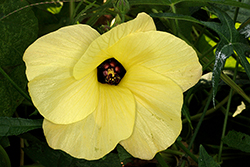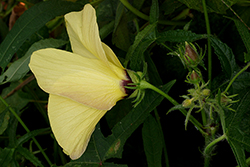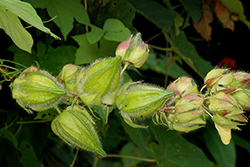e-Flora of Thailand
Volume 14 > Part 2 > Year 2019 > Page 267 > Malvaceae > Abelmoschus
5. Abelmoschus moschatus Medik.wfo-0000510888
Malvenfam.: 46. 1787; Hochr. Candollea 2: 86. 1924; Borss.Waalk., Blumea 14: 90. 1966; Fryxell, Syst. Bot. Monogr. 25: 22. 1988; Sivar. & Pradeep, Malvaceae of S. Penins. India: 70. 1966; Y.Tang et al. in C.Y. Wu et al., Fl. China 12: 285. 2007.
Accepted Name : This is currently accepted.
Synonyms & Citations :
Description : Annual herb or subshrubby herb, 0.4–2 m tall; with taproot, stem erect,; stem, petioles and peduncles usually densely covered with mostly hispid, simple hairs and minute stellate hairs, rarely glabrous. Leaves palmately (3–)5-lobed or angular, hastate or sagittate, 4.5–16 by 5.5–26 cm, upper surface with scattered simple hairs, lower surface stellate hairs, along midrib and nerves with simple hairs. Petiole 2–30 cm long. Stipules linear 0.5–1 cm long, hairy. Flower axillary, solitary, 8–9 cm in diam. Peduncle 1.5–6.5 cm long, hairy. Epicalyx lobes 6–10, linear to lanceolate, 8–18 by 1–2 mm, with scattered long patent hairs. Calyx 1–3 cm long, hairy. Corolla yellow with a dark red-purple center. Petals obovate, 3.5–7.5 by 3–6 cm glabrous. Staminal column 1.5–3 cm long; filament ca 1 mm long; anther ca 0.5 mm. Ovary ovoid, 5–7.5 by 3–5 mm, hairy; stylar branches 2–3 mm long, hairy; stigmas disk-shaped. Capsule ovoid or ellipsoid, 4–6 by 2–3 cm, beaked, outer surface hispid, glabrescent, inner surface glabrous. Seeds ovoid-reniform, 3.5–4 by 3–3.5 mm glandularly striate, brownish or black; musk-scented.
Thailand : NORTHERN: Chiang Mai (Chiang Dao, Fang); Chiang Rai (Mae Kok), Nan (Ban Sop Khun), Phrae, Kamphaeng Phet (Khao Son); NORTH-EASTERN: Khon Kaen (Phu Khieo); EASTERN: Nakhon Ratchasima (Khao Yai), Buri Ram (near Nang Rong); SOUTH-WESTERN: Prachuap Khiri Khan (Kui Buri); CENTRAL: Krung Thep Maha Nakhon (Bangkok), Saraburi (Muak Lek); SOUTH-EASTERN: Chanthaburi (Pong Nam Ron), Trat (Khao Saming); PENINSULAR: Songkhla (Tham Rue Nok Sak), Pattani (Ban Nang Sata).
Distribution : India, S China, Cambodia, Laos, Vietnam, Malesia, the Pacific Islands.
Ecology : Evergreen forests, edge of evergreen forests, wet ground, in rice field, waste areas, 180–850 m alt. Flowering and fruiting: nearly all the year round.
Vernacular : Kia (เกี้ย)(Chanthaburi); chamot ton (ชะมดต้น), fai phi (ฝ้ายผี)(Trat).
Uses: Cultivated for fibres and seed oil.



